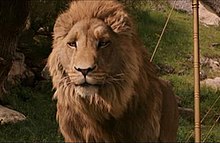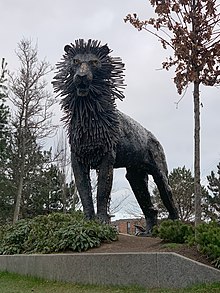Aslan
| Aslan | |
|---|---|
| Narniacharacter | |
 Aslan in the 2005 filmThe Chronicles of Narnia: The Lion, the Witch and the Wardrobe, voiced byLiam Neeson. | |
| First appearance | The Lion, the Witch and the Wardrobe(1950) |
| Last appearance | The Last Battle(1956) |
| Created by | C. S. Lewis |
| Voiced by | Liam Neeson |
| In-universe information | |
| Race | TalkingLion/Deity |
| Family | Emperor-Over-the-Sea(father) |
| Nationality | Aslan's Country |

Aslan(/ˈæslæn,ˈæz-/) is a major character inC. S. Lewis'sThe Chronicles of Narniaseries. Unlike any other character in the Narnian series, Aslan appears in all seven chronicles.[1]Aslan is depicted as atalkinglionand is described as the King of Beasts, the son of theEmperor-Over-the-Sea,[2]and the King above all High Kings in Narnia.[3]
C.S. Lewis often capitalizes the wordlionin reference to Aslan since he parallelsJesusas the "Lion of Judah"inChristian theology.[4]The wordaslanmeans "lion" inTurkish.[4][5]
Role inThe Chronicles of Narnia
[edit]Aslan is first mentioned byMr. Beaverwhen the Pevensie children arrive inNarnia.He is described by Mr. Beaver as being the true king of Narnia who has returned to help the Pevensies to free Narnia of theWhite Witch's rule.
Mr and Mrs. Beaver guidePeter,SusanandLucyto thestone tableto meet Aslan. They inform Aslan thatEdmundhas betrayed them by joining the White Witch. Aslan sends some of his followers to rescue Edmund. The next day, Aslan is approached by the White Witch who demands her right to kill Edmund, as the deep magic states that all traitors belong to her. Aslan discusses the matter in private with the Witch, persuading her to release Edmund.
That same night, Aslan travels to the stone table with Susan and Lucy. The Witch and her followers bind Aslan to the stone table—it is revealed that Aslan had agreed to be killed to save Edmund. However, due to a deeper magic (which the Witch was unaware of), Aslan is brought back to life and manages to rescue his followers who have been turned to stone by the Witch. He brings his followers to the battle where he kills the Witch himself, ending her tyranny once and for all.
Aslan is present at thecoronationof the four Pevensie children. He then leaves to attend to other duties with Mr. Beaver convincing the Pevensie children that he will be coming and going.
The Pevensies are summoned into Narnia from their world to helpCaspian—the rightful King of Narnia—overthrow his usurpingUncle Mirazand restore freedom to the land. When they get lost in the forest, Aslan calls Lucy to lead her siblings to him; some obey more faithfully than others. Aslan helps Peter, Edmund, andTrumpkin the Dwarfto come to Caspian's aid in time to thwart an attempt on his life. Aslan then leads an army of awakened Trees andMaenadsto victory against Miraz'sTelmarineoccupation. He later crowns Caspian as King and creates a door whereby surviving Telmarines can leave the Narnian world if they so choose.
Edmund and Lucy Pevensie are transported to the eastern ocean of the Narnian world along with their cousin, the recalcitrantEustace,where they join King Caspian on a seafaring journey. When Eustace falls under an enchantment and becomes adragon,Aslan delivers him from the enchantment. Aslan appears at various points of the journey to provide guidance. When they reach the world's end, Aslan appears as alambbefore returning to his usual form. He showsReepicheep(a talking mouse) the way toAslan's Country.
Aslan brings Eustace and his classmateJillto Narnia. He explains to Jill that she and Eustace are charged with the quest of finding King Caspian's son,Prince Rilian(who had disappeared years before), and gives her four Signs to guide them on their quest. Aslan makes no further appearances until the end of the story, but his Signs prove central to the successful quest. When he returns Eustace and Jill to their world, Aslan shows himself to the bullies at their school to frighten them.
Aslan's influence is at first hidden from the characters. Prior to the story's opening, he delivered the infant Prince Cor ofArchenlandfrom his enemies to aCalormenefisherman who named himShasta.At one point in the book, Aslan—pretending to be a common "witless" lion—chases Shasta and the talking horseBreeso that they will meetAravisandHwin,who become their traveling companions. He comforts Shasta in the form of acatand defends him as he sleeps; later, he chases Shasta and the others so that they will reach Archenland in time to warn that nation of the impending attack of PrinceRabadashof Calormen. After Rabadash is defeated, Aslan turns him into a donkey as punishment.
This book tells the story of Aslan's creation of Narnia, his crowning of its first King and Queen, and his gift of the power of speech to some of the animals. Aslan tells the two main characters—Digory KirkeandPolly Plummer—that the evil Jadis (later to become the White Witch) will pose a great threat to the Narnians. Aslan charges Digory and Polly with a quest to acquire a magicapplethat, when planted, will protect Narnia from Jadis.
ThoughShift the Apeand the other villains act in his name (dressing the naïve donkeyPuzzlein a lion-skin), Aslan himself only appears late in the story in a paradise entered through a stable door. He brings Narnia to an end, and leads into his own country such of its inhabitants who, coming to the Stable Door as the world ends, look into his face and love him, some to their own surprise. At the end of the book, he informs the other characters that "all of you are—as you used to call it in the Shadowlands—dead", and that the afterlife in which they now find themselves is the true reality as they go "further up and further in".
Influences
[edit]Christian interpretation
[edit]Although Aslan can be read as an original character, parallels exist withChrist.[6]According to the author, Aslan is not anallegoricalportrayal of Christ, but rather a suppositionalincarnationof Christ Himself:
If Aslan represented the immaterialDeity,he would be an allegorical figure. In reality however, he is an invention giving an imaginary answer to the question, "What might Christ become like if there really were a world like Narnia and He chose to be incarnate and die and rise again in that world as He actually has done in ours?" This is not allegory at all.[7]
In one of his last letters, Lewis wrote, "Since Narnia is a world of Talking Beasts, I thought He [Christ] would become a Talking Beast there, as He became a man here. I pictured Him becoming a lion there because (a) the lion is supposed to be the king of beasts; (b) Christ is called" The Lion of Judah "in the Bible; (c) I'd been having strange dreams about lions when I began writing the work."[8]
The similarity between the death and resurrection of Aslan and thedeath and resurrection of Jesusis obvious; one author has observed that like Jesus, Aslan was ridiculed before his death, mourned, and then discovered to be absent from the place where his body had been laid.[9][10][11]In this interpretation, the girls Susan and Lucy who witness Aslan's death, mourn him and witness his resurrection would stand forThe Three Marysof Christian tradition.
Aslan's words to the Calormene inThe Last Battle( "I take to me the services which thou hast done to [the false god]... if any man swear by [him] and keep his oath for the oath's sake, it is by [Aslan] that he has truly sworn, though he know it not, and it is I who reward him" ), ratifying the good deeds the latter did even in service to a false god, have been the subject of controversy because they implicitly endorseinclusivism.[12]
Adaptations
[edit]In the1967 TV serial,Aslan was portrayed byBernard Kay.
In the1979 animated film,Aslan was voiced byStephen Thorne,who later voiced Aslan in all seven of the BBC Radio 4 Tales of Narnia series.[13][14]
In theBBCtelevision adaptations ofThe Chronicles of Narnia,Aslan was performed byAilsa BerkandWilliam Todd-Jonesand voiced byRonald Pickup.[15][16]
In theFocus on the FamilyRadio Theatre dramatisations, Aslan was portrayed byDavid Suchet.
In the 2005 film,The Chronicles of Narnia: The Lion, the Witch and the Wardrobe,theCGIAslan was voiced byLiam Neeson.Neeson also voiced Aslan in the sequel,The Chronicles of Narnia: Prince Caspianin 2008, and in the third film in the series,The Chronicles of Narnia: The Voyage of the Dawn Treaderin 2010.[17]
References
[edit]- ^Carter, Joe (16 June 2017)."9 Things You Should Know About The Chronicles of Narnia".Archivedfrom the original on 2018-10-18.Retrieved2018-10-18.
- ^"Gallery: Royal Mail: Stamps from magical realms".The Guardian.March 9, 2011.Archivedfrom the original on 2018-10-11.Retrieved2018-10-11– via theguardian.
- ^Will Vaus (30 March 2004).Mere Theology: A Guide to the Thought of C. S. Lewis.InterVarsity Press. pp. 146–.ISBN978-0-8308-2782-4.
- ^abThe Collected Letters of C.S. Lewis, vol iii, p 160: "I found the name [Aslan]...it is the Turkish for Lion.... And of course it meant theLion of Judah."
- ^Langenscheidt Pocket Turkish Dictionary.Langenscheidt publishing group. 2006. p. 428.ISBN9781585735228.Retrieved25 October2020.
- ^"Religion in the Chronicles of Narnia".November 21, 2013.Archivedfrom the original on 2018-10-12.Retrieved2018-10-18– via bbc.co.uk.
- ^Root, Jerry; Martindale, Wayne (12 March 2012).The Quotable Lewis.Tyndale House Publishers, Inc. pp. 59–.ISBN978-1-4143-5674-7.
- ^Ford, Paul (2005).Companion to Narnia: Revised Edition.San Francisco:HarperCollins.p.6.ISBN978-0-06-079127-8.
- ^John Visser."Into the Wardrobe".Archivedfrom the original on 2012-01-15.Retrieved2018-10-18.
- ^"Christian Themes In The Lion, The Witch and the Wardrobe - The Narnian".Archivedfrom the original on 2018-10-18.Retrieved2018-10-18.
- ^"Reading Matters: Page moved".Archivedfrom the original on 2017-02-17.Retrieved2018-10-18.
- ^McCormack, Elissa (2008). "Inclusivism in the Fiction of C.S. Lewis: The Case of Emeth".Logos: A Journal of Catholic Thought and Culture.11(4): 57–73.doi:10.1353/log.0.0017.S2CID170304073.
- ^"C.S. Lewis – Tales Of Narnia: The Lion, The Witch, And The Wardrobe".Discogs.
- ^"C.S. Lewis – The Chronicles Of Narnia: Prince Caspian: A BBC Radio 4 Full-Cast Dramatisation".Discogs.Retrieved10 May2021.
- ^"The Chronicles of Narnia (UK)".TV.Archived fromthe originalon 2016-08-23.Retrieved2020-09-11.
- ^Fordy, Tom (23 December 2021)."How the Lion, the Witch and the Wardrobe made the BBC take children seriously".The Daily Telegraph.
- ^"Caspian to be Second Narnia movie".BBC News.18 January 2006.Archivedfrom the original on 2008-12-30.Retrieved1 December2006.
External links
[edit]- Imdb: Aslan
- SparkNotes reference to the meaning of Aslan's death
- "Aslan is still on the move"Christianity Todayeditorial, 6 August 2001.
